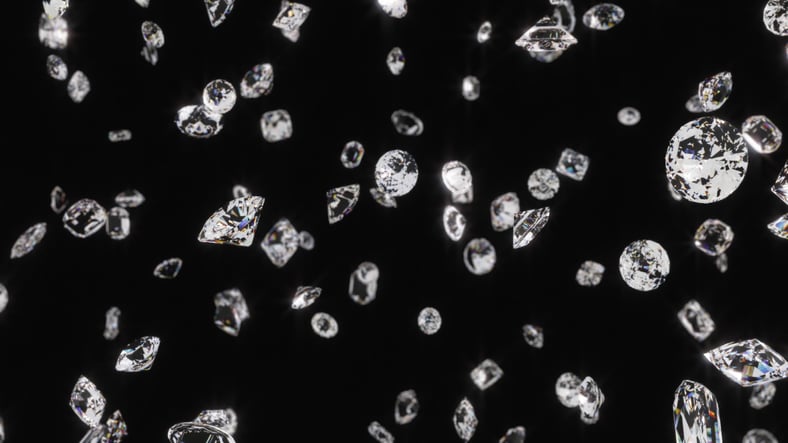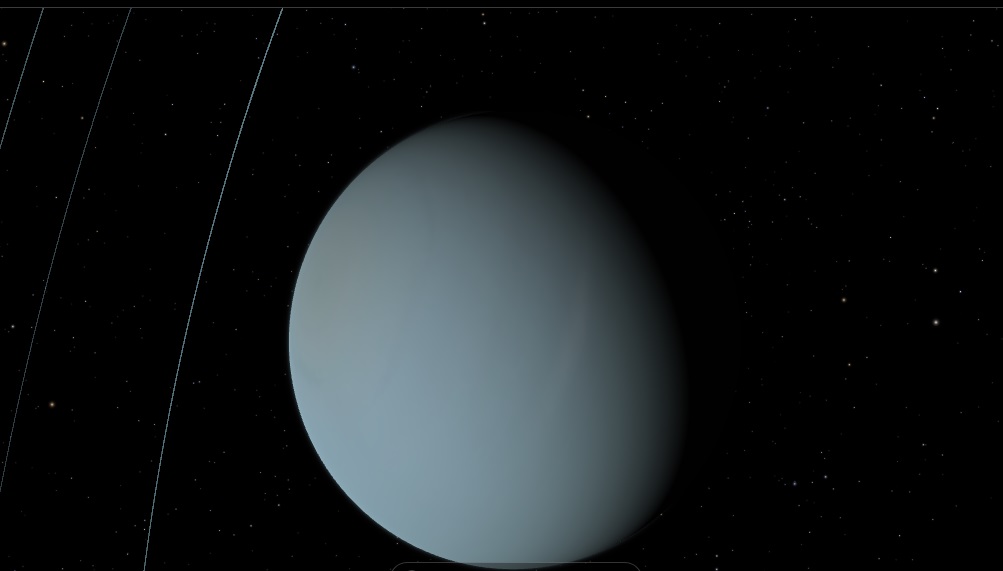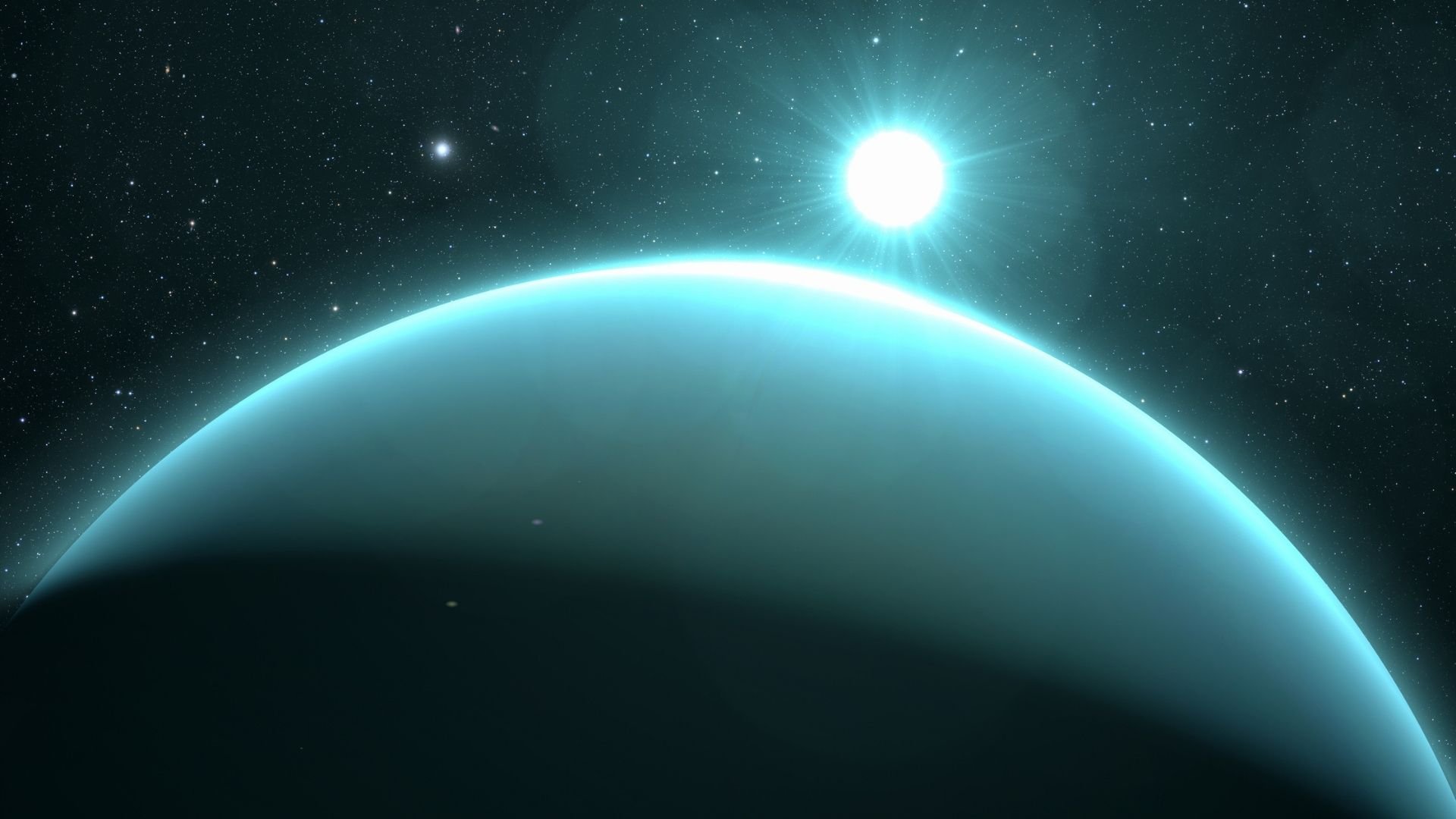Astronomer William Herschel discovered Uranus in 1781, although at first, he believed it to be either a comet or a star, making it the first planet to be spotted with the use of a telescope.
Two years later, in part as a result of observations by astronomer Johann Elert Bode, the object was unanimously acknowledged as a new planet. Herschel made an unsuccessful attempt to give his find the name Georgium Sidus in honor of King George III. Instead, Bode’s recommendation to name it after the Greek god of the sky, Uranus, was approved by the scientific community.
Does Uranus have diamond rain?
Uranus and Neptune may initially appear to be unremarkable, uninteresting balls of stuff. But this belies something absolutely fascinating about them–they may have rain made of actual diamonds!
The idea of diamond rain on these planets was initially hypothesized prior to the 1977 launch of the Voyager 2 mission. But why?
We know broadly what Uranus and Neptune are comprised of, and we are aware that material becomes hotter and denser as it travels deeper within a planet.

The mathematical modeling fills in the details, including the likelihood that the innermost portions of the mantles of these planets have temperatures around 7,000 kelvins (12,140°Fahrenheit, or 6,727°Celsius), as well as pressures 6 million times greater than those of Earth’s atmosphere.
The same models inform us that the uppermost mantle layers are slightly less pressured (200,000 times Earth’s atmospheric pressure) and cooler (2,000°K or 3,140°F or 1,727°C). Therefore, it is only logical to wonder what happens to water, ammonia, and methane under conditions of that kind of heat and pressure.
Particularly with methane, high pressures can split the molecule, releasing the carbon. The carbon then connects with its siblings to form lengthy chains. The lengthy strands are then compressed together to create diamond-like crystalline patterns.
When it becomes too hot, the thick diamond formations “rain” down the mantle layers until they evaporate, float back up, and resume the cycle—hence the name “diamond rain.”
Does Uranus have water?
Yes, sort of.
The ice giant planets Uranus and Neptune are water-rich worlds with deep layers of ice or, as some scientists believe, possibly liquid water beneath their thick atmospheres.
Compared to the ice deposits and/or subsurface lakes on Mars, as well as the oceans on Earth, the internal “oceans” of these planets would be larger. But, we know very little, if anything, about them.

In May 2021, researchers in the U.S. and South Korea announced some new findings suggesting the water layers of these exotic water worlds might be rich in magnesium.
Uranus and Neptune are water-rich planets in contrast to the gas giants Jupiter and Saturn. There may even be a liquid layer on top of the ice, which makes up the majority of the water. Deep underground, where water interacts with the rocky mantle, activities are taking place that scientists are trying to understand.
“Through this study, we were seeking to extend our knowledge of the deep interior of ice giants and determine what water-rock interactions at extreme conditions might exist,” Taehyun Kim, lead author at Yonsei University in South Korea explained.
“Ice giants and some exoplanets have deep water layers, unlike terrestrial planets. We proposed the possibility of an atomic-scale mixing of two of the planet-building materials (water and rock) in the interiors of ice giants,” he added.
This is interesting in and of its own right, but the study’s findings might help clear up something about Uranus (and Neptune) that has plagued scientists for decades.
Despite the fact that both Uranus and Neptune are abundant in water, for some reason, Uranus’ atmosphere is much colder than Neptune’s. This has perplexed scientists, but there may finally be a solution.
Magnesium may prevent heat from the planet’s interior from escaping to the outer atmosphere if it is found in Uranus’ aqueous layer.
Why are Uranus and Neptune different colors?
We’ve seen that Neptune and Uranus share some interesting characteristics, but one major difference between the two is their respective colors. So why are they different in this respect?

Neptune is noticeably bluer than Uranus at visible wavelengths, while Uranus exhibits a faint cyan tint. The two planets’ distinct colors can now be explained by astronomers.
According to recent studies, Uranus’s concentrated haze layer is thicker than that of Neptune’s, and it “whitens” Uranus’s appearance more than Neptune’s. The atmospheres of Neptune and Uranus would seem nearly identically blue if there were no haze in either one.
This assertion is supported by a model that an international team under the direction of Patrick Irwin, an Oxford University professor of planetary physics, created to characterize the aerosol layers in the atmospheres of Neptune and Uranus. Prior research on the higher atmospheres of these planets concentrated on how the atmosphere looked exclusively at particular wavelengths.
However, throughout a wide range of wavelengths, this new model, which consists of many atmospheric layers, agrees with evidence from both planets. The deeper layers, which were previously believed to exclusively contain clouds of methane and hydrogen sulfide ices, are now included in the new model as well.
The black spots that are occasionally visible on Neptune and less frequently found on Uranus can also be explained by the model too. Although astronomers were already aware that both planets’ atmospheres contained black areas, they were unsure of what layer of aerosols was to blame or why that layers’ aerosols were less reflecting.
The team’s research provides answers to these problems by demonstrating that a darkening of their model’s lowest layer would result in dark areas resembling those observed on Neptune and maybe Uranus.
2. Compared to Earth, Uranus is huge
Uranus has a diameter of about four times the size of Earth. The planet has a radius that is 15,759.2 miles (25,362 kilometers), compared to Earth’s radius of 3,959 miles (6,371 km).
Since that might be a little difficult to actually visualize, if we were to shrink Earth to the size of a large apple, Uranus would be the size of a basketball by comparison.
Uranus is 19.8 astronomical units from the Sun, about 1.8 billion miles (2.9 billion kilometers) distant on average. The distance between the Sun and Earth is one astronomical unit or AU. Sunlight travels from the Sun to Uranus in 2 hours and 40 minutes from this distance.
That’s pretty big, but even Uranus is a fairly small planet in the greater scheme of things.
3. Uranus’ atmosphere is not conducive to life

The atmosphere of Uranus is inhospitable to life as we know it. As far as we can ascertain, life as we know it could not adapt to the severe and volatile temperatures, pressures, and materials that make up this planet.
With a small amount of methane and traces of water and ammonia, the atmosphere of Uranus is primarily composed of hydrogen and helium. Methane is responsible for Uranus’ distinctive blue hue.
More recent observations show that Uranus has dynamic clouds as it approaches the equinox, including fast-changing bright structures. Voyager 2 observed only a few discrete clouds, a Great Black Patch, and a small dark spot during its flyby in 1986.
In some locations, Uranus’ planetary atmosphere is considerably colder than Neptune, with a minimum temperature of 49°K (-224.2°Celsius).
On Uranus, wind gusts can reach a maximum of 560 miles per hour (900 kilometers per hour). At the equator, winds are retrograde, moving in the opposite direction of the planet’s rotation. However, as one gets to the poles, the wind changes to a prograde direction and moves with Uranus’ rotation.
4. Uranus’ orbit and rotation are extraordinary indeed
On Uranus, a day lasts roughly 17 hours (the time it takes for Uranus to rotate or spin once). And it takes Uranus roughly 84 Earth years to complete one orbit of the Sun.
Put another way, one year in Uranian time equates to about 30,687 days on Earth.
Uranus has a tilt of 97.77 degrees and is the only planet whose equator is almost at a straight angle to its orbit. We are not entirely sure why, but Uranus may have collided with an Earth-sized object long ago.
The most intense seasons in the solar system are brought on by this peculiar tilt. The Sun shines directly over each pole for over a quarter of every Uranian year, sending the other half of the planet into a 21-year-long, gloomy winter.
Additionally, just two planets, Uranus and Venus, rotate from east to west, in the opposite direction from the majority of the planets.
5. Uranus has a lot of moons

There are 27 known moons that orbit Uranus. The moons of Uranus are distinctive in that they are named after characters from William Shakespeare and Alexander Pope, unlike the majority of satellites that orbit other planets, whose names are derived from Greek or Roman mythology.
All of Uranus’ inner moons seem to be made up nearly equally of rock and water ice. The outer moons’ makeup is unclear, however, and it is likely that they are asteroids that have been captured.
6. It has some rings too

Not only does Uranus have some moons, but it also has three sets of rings too. There are at least 11 rings. There are nine narrow main rings, followed by the two more recently discovered outer rings. The inner rings are dark and opaque, with a very low albedo. Astronomers believe that they’re made of water ice mixed with organic molecules. The outermost ring is blue like Saturn’s E ring, and the outer ring is reddish like other dusty rings in the solar system.
The names of the rings are Zeta, 6, 5, 4, Alpha, Beta, Eta, Gamma, Delta, Lambda, Epsilon, Nu, and Mu, with Zeta being the closest to the planet.
Belts of fine dust encircle several of the bigger rings, which are often argued to be rings in and of themselves.
7. There is no “true” surface to the planet

Since it is an ice giant, Uranus lacks a real surface, so to speak. This is because most of the planet is made up of swirling fluids.
A spacecraft wouldn’t be able to travel through Uranus’ atmosphere unharmed, but it also wouldn’t have anywhere to land. If ever attempted, a metal spaceship would be destroyed by the intense pressures and temperatures.
At least that is with our current knowledge of material science.
8. Uranus has a very strange magnetosphere too

Uranus, as we’ve seen, is a very strange place indeed. But it gets weirder.
The magnetosphere of Uranus appears to be unusually formed. Magnetic fields are generally aligned with a planet’s rotation. However, the magnetic axis of Uranus has tilted about 60 degrees away from the planet’s axis of rotation and is also displaced from the planet’s center by a third of its radius.
The uneven magnetic field of Uranus causes auroras to not line up with the poles as they do on Earth, Jupiter, and Saturn.
Millions of miles of space are covered by the magnetosphere tail that follows Uranus to the other side of the Sun. Uranus’ sideways rotation causes its magnetic field lines to twist into a lengthy corkscrew shape.
9. Uranus is made of “hot” icy stuff

Uranus is one of two ice giants in the outer solar system (the other is Neptune). Over a tiny rocky core, hot, dense fluid of “icy” components like water, methane, and ammonia makes up the majority (80% or more) of the planet’s mass. Temperatures can reach 9,000°Fahrenheit (4,982°Celsius) towards the core.
Despite having a lesser mass, Uranus has a somewhat bigger diameter than its neighbor, Neptune. Saturn is the least dense planet, making Uranus the second least dense after that.
Due to the presence of methane gas in its atmosphere, Uranus has a blue-green tint. Sunlight enters the atmosphere of Uranus and is reflected by its cloud tops back out into space. Blue-green light is produced when methane gas absorbs the red component of the light spectrum.
10. Uranus is the coldest planet in the Solar System

Uranus, the seventh planet from the Sun, orbits at an average distance of about 2.88 billion kilometers. However, it is still a lot closer than Neptune, which is on average 1.74 billion miles (4.5 billion kilometers) from the Sun.
This does not, however, change the fact that Uranus is colder than Neptune. The former has temperatures that range from a low of -360 °F (-218 °C) to an average of -330 °F (-201 °C).
On the other hand, Uranus’ cloud top temperatures, which are considered to be the “surface temperature” for gas giants, range from -375 °F (-226 °C) to an average of -323 °F (-197.2 °C). This is because Uranus emits less heat than it takes in from the Sun, in contrast to the other big planets in the Solar System. While the cores of the other major planets are extremely hot and emit infrared radiation, Uranus’ core has cooled down to the point where it emits little energy.
11. You can actually see Uranus with the naked eye

You might be shocked to learn that a telescope is not always necessary to observe Uranus. Uranus is barely within the range of brightness that the human eye can detect at magnitude 5.3. However, you would need to know exactly where to look and ensure that the night sky was very dark (i.e., there was no light pollution).
Because of this, ancient and early modern astronomers were able to see Uranus quite frequently in the past. However, because of how dim it was in comparison to the other planets, it was frequently mistaken for a star.
In fact, when Flamsteed first noticed it, he categorized it as 34 Tauri because he thought it was a star in the constellation of Taurus.
12. We’ve only been to the planet once

In the entire history of space travel, only one spacecraft has ever visited Uranus. On January 24th, 1986, NASA’s Voyager 2 made its closest approach to Uranus, passing just 50,331 miles (81,000 kilometers) from the planet’s cloud tops. The gas/ice giant and its moons were captured in tens of thousands of pictures before the spacecraft accelerated toward its next destination, Neptune.
There are no present plans to launch any more spacecraft that could be directed toward Uranus. During a mission extension planning phase in 2009, the prospect of transporting the Cassini spacecraft from Saturn to Uranus was considered.
The Uranian system would have taken Cassini around 20 years to reach after leaving Saturn, therefore this never materialized. Although there are a number of ideas for getting back to Uranus being bounced around, none have yet been approved.
13. Uranus is named after the ancestor of the gods (and titans)

The Greek personification of the heavens and son of Chaos, Uranus, is the inspiration for the name of the planet. As previously mentioned, this makes it the only planet that was given the name of a Greek god rather than a Roman one.
Traditionally, Uranus was considered an offspring of Gaia, Mother Earth, who emerged from primeval Chaos. Hesiod states that Gaia created Uranus as “equal to herself, to cover her on every side, and to be an ever-sure abiding-place for the blessed gods.”
With Gaia, Uranus produced eighteen children, including the twelve Titans, the three one-eyed Cyclopes, and the three Hecatoncheires (giants with a hundred hands).
14. The planet has a strange dark spot

In some respects, the atmosphere of Uranus is thought to be the calmest of the large planets. Only a few tiny clouds were seen when the Voyager 2 spacecraft initially neared it. However, there are still some atmospheric inhomogeneities.
The 2006 discovery of the so-called “Great Dark Spot” on Uranus was a prime example. It is similar to the same phenomenon on Neptune.
This dark spot is a vortex measuring 1,100 miles by 1,900 miles, where the wind speed can reach 447 mph (200 m/s) and is caused by churning winds in the planet’s atmosphere.
15. Uranus probably smells like rotten eggs
In 2018, Gemini’s near-infrared integral-field spectrograph (NIFS) was used to determine the composition of the upper layers of the Uranian atmosphere. It was discovered that the clouds in these levels are made of frozen hydrogen sulfide. This is the same ingredient that gives rotting eggs their distinctive odor.
This substance’s presence in the planet’s upper layers is proof that Uranus did not develop in its current orbit. It was, therefore, probably born closer to the Sun than any other huge planet, and over the first tens of millions of years of its existence, it moved to where it is now.
And that is your lot for today.
Uranus is certainly a strange planet, but we have only touched the surface when it comes to understanding much about it. With some new missions to the planet planned in the future, we can only imagine what we will learn about our planet’s very distant cousin.
 SHOW COMMENT (1)
SHOW COMMENT (1)











